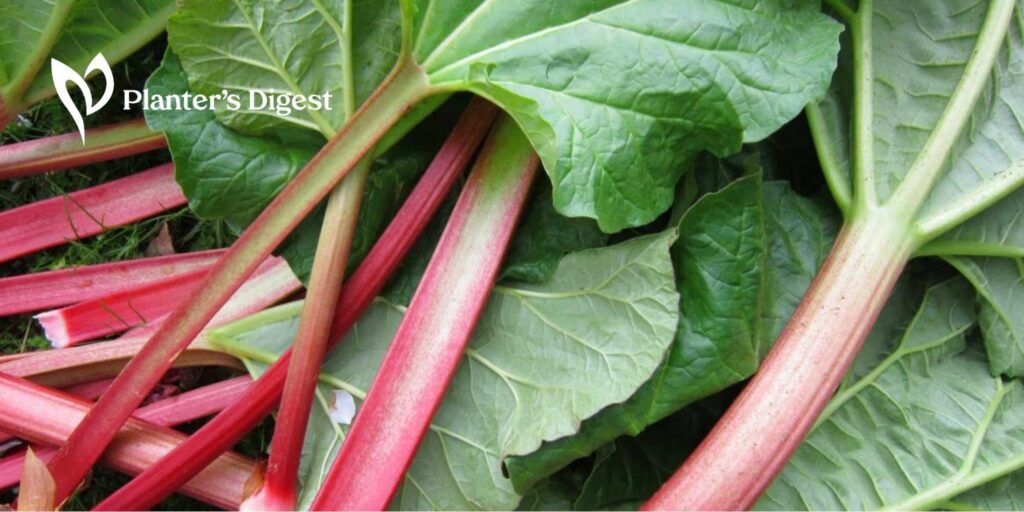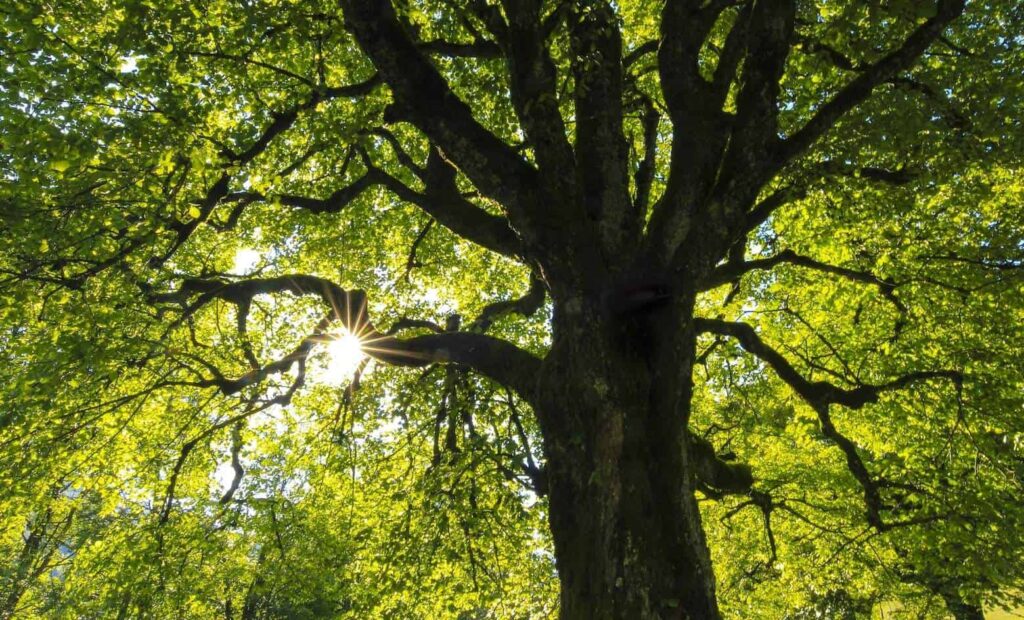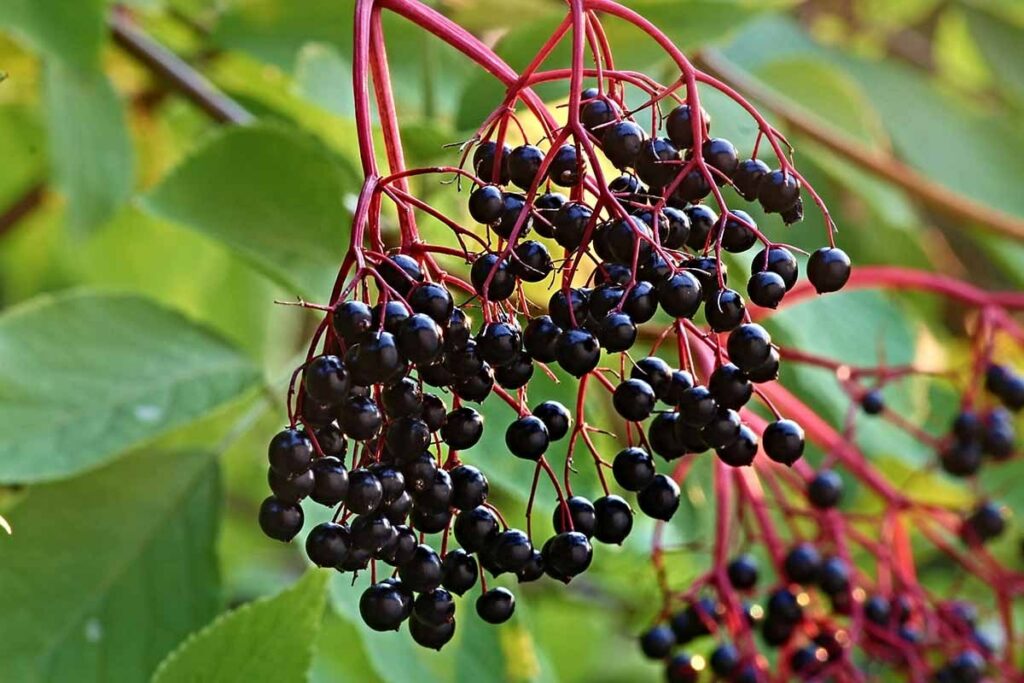What’s green, red, sweet, and tart? We’re talking rhubarbs!
The rhubarb is a perennial plant with thick stalks and large leaves. The stalks are edible, in vibrant red or pink, but the leaves are toxic and should not be consumed.
But what do we really know about it? And how do we grow and harvest our own?
Read on to learn more!
What does rhubarb look like?
The rhubarb plant is a perennial vegetable with edible stalks and poisonous leaves. Its stalks are typically red or pink but can also be green or speckled, and can extend up to 18 to 24 inches long.
Rhubarb thrives in cooler climates, making it popular in northern gardens. It’s easy to grow but in order to flourish and yield abundant stalks, it requires a dormancy period.
Only the stalks of the rhubarb plant are edible, offering a rich, tart flavor when cooked. The leaves are toxic due to oxalic acid, so avoid ingesting them.
With its ruby or green stems and umbrella-like leaves, rhubarb adds height, structure, and a splash of gorgeous color to your garden, returning year after year.
How big does rhubarb get?
Rhubarb plants can grow large, reaching 2 to 3 feet in height and spreading 3 to 4 feet wide.
When to Plant Rhubarb
Plant rhubarb in late fall or early spring. In the fall, plant the crowns after dormancy has set in, and you’ll enjoy rhubarb cropping in the spring!
For spring planting, do it as soon as the soil is workable, while the roots are still dormant and before growth begins – or when plants are just starting to leaf out. Soil temperature should be at least 50 F if you have a temperature gauge.
For optimal growth, choose a planting location with an average winter temperature below 40 F and a summer temperature below 75 F. For best results, give it its own quiet corner in the garden, undisturbed.
How long does it take rhubarb to grow?
It takes 1 to 2 years for rhubarb to grow and become established for harvesting. In the first year, it concentrates on building strong roots.
During this time, we recommend avoiding harvesting any stalks to ensure proper development.
Where to Grow Rhubarb

Rhubarb prefers cool climates and grows in USDA zones 3 to 8. Rhubarb can be productive for many years but may decline after 8 to 10 years.
Plant in well-draining, fertile soil with full sun or partial shade. Water regularly, but avoid waterlogged conditions.
It takes 1 to 2 years for rhubarb to become established before harvesting. Mature plants reach a height of 2 to 3 feet with stalks up to 18 to 24 inches long.
Rhubarb is low-maintenance, making it easy to grow. However, patience is needed as it takes time to establish before harvesting.
How to Grow Rhubarb Plants
| Ease of Care | Low ●○○○○ |
| Growing Season | Rhubarb is a perennial harvested in spring. Actual growing season varies by local climate and frost patterns. |
| Sunlight Requirements | Rhubarb thrives in full sun to partial shade. Proper light exposure promotes strong growth and vibrant color. |
| Soil Conditions | Well-drained, fertile soil enriched with compost benefits rhubarb. Ensure good drainage to prevent rot. |
Alright, let’s get your rhubarb plants set up for success! We usually plant rhubarb either as bare-root crowns or potted plants during early spring or late fall, so here are the guidelines to grow them properly.
How to Cultivate the Rhubarb Plant
1. Find the perfect spot.
Look for a well-draining location with fertile, loamy soil that’s been enriched with organic matter.
2. Dig an adequately spaced hole.
Make a hole deep and wide enough to fit the rhubarb crown comfortably. Leave the top buds just above the soil level.
3. Give the rhubarb plant space.
If you’re planting multiple rhubarb plants, make sure to give them some elbow room. Space them at least 3 to 4 feet apart, so they can grow freely without any cramped roots.
4. Opt for 1-year-old rhubarb crowns.
You can get 1-year-old rhubarb crowns from a garden center, nursery, or order them online. They usually come as bare-rooted specimens or young plants already in pots, all ready for planting.
We normally don’t recommend growing from seeds as they don’t tend to grow similarly to the parent plant.
5. Weed out the weeds.
Before planting, get rid of any sneaky perennial weeds in your chosen spot.
6. Orient the rhubarb crowns properly.
Plant the crowns so the little buds are about 2 inches below the soil surface, and make sure those buds are facing up like they’re looking to the sky.
7. Water the rhubarb plant.
Last but not least, give your new rhubarb plants a good drink of water when you put them in the ground.
Planter’s Tips
- To prevent overcrowding and promote optimal growth, regularly dig and split rhubarb roots every 3 to 4 years. Do this while the plants are dormant in early spring or late fall, ensuring that each division has at least one large bud.
- For moisture retention and weed prevention, generously mulch with a thick layer of straw.
- Keep your rhubarb plant well-watered and consistent, especially during hot, dry summer days when it needs sufficient moisture.
- Remove seed stalks promptly to save the plant’s energy for producing stalks or roots.
- In spring, lightly sprinkle a 10-10-10 fertilizer as the ground thaws so check your local frost dates for the best timing.
- During fall, clear all plant debris and cover the rhubarb with 2 to 4 inches of organic mulch, preferably well-rotted compost. This adds nitrogen to the soil, preparing the rhubarb for a successful spring season.
The rhubarb plant also grows well in a large container. Look for one with a capacity of at least 10 gallons.
Established plants require dividing every 5 to 10 years when stems become crowded and thin. Do this during dormancy, either in early spring or fall.
Gently dig and lift clumps, cutting roots into 2-inch pieces. Be careful not to harm the buds on top of each root section and replant only the best sections.
Temperature for Rhubarb
The rhubarb plant loves cooler temperatures and can handle cold winters, thriving in the range of 40 to 75 F during its growing season.
For those interested in growing from seeds, you can sow rhubarb seeds directly into the soil outdoors, 2 to 4 weeks before the last frost. We recommend looking up frost dates from your preferred Almanac sources.
In areas with short growing seasons, start rhubarb seeds indoors 8 weeks before transplanting them to the garden.
Alternatively, you can buy rhubarb crowns and plant them in early spring when the ground is workable or in the fall, 4 to 6 weeks before the first fall frost while the crowns are dormant.
To achieve the best germination, maintain a soil temperature between 70 and 80 F, not the air temperature. Use a probe-type thermometer to check the soil temperature.
If the soil temperature is too low, consider waiting for the sun to warm it up or use a cloche, which is a plastic or glass cover, to trap heat and warm the air and soil around the rhubarb seeds. A simple cloche can be made from a plastic water bottle.
Watering for Rhubarb
Rhubarb needs regular watering, especially during dry periods, but avoid waterlogging the soil. Keep the soil consistently moist by watering deeply and less frequently.
Ensure the entire root ball gets wet when watering. Using mulch on top of the soil helps retain moisture, especially in hot, dry weather.
Be cautious not to overwater, as it can cause root rot and eventual death. To decide when to water, feel the soil with your fingers.
If it feels dry about 2 or 3 inches below the surface, it’s time to water. Water early in the morning to allow proper soaking before evaporation.
Fertilizing for Rhubarb
In early spring, use a balanced fertilizer or well-rotted compost for essential nutrients. When the ground freezes, cover rhubarb with 2 to 4 inches of compost.
For fertilizing, apply half a cup of 10-10-10 fertilizer per plant before growth starts. Switch to nitrogen-only fertilizer after 4 to 5 years for most soils.
Common Rhubarb Issues
Fortunately, the rhubarb plant faces a few issues. It can, however, get occasional and unexpected issues
Poor soil drainage causes crown rot, damaging terminal buds and leading to weak stems. If affected, dig out and burn infected plants, avoiding replanting in the same area.
Leaf spots can also attack the plant, with red leaf or Ramularia being the worst, ruining stems. To prevent leaf spot, cut away old foliage in the fall since spores overwinter in debris.
Rhubarb curculio occasionally attacks, puncturing leaf stalks while feeding and laying eggs from late spring to early summer. Damaged stems ooze sap and may decay.
Companion Plants for Rhubarb
Good companion plants for rhubarb are other perennials like artichokes and asparagus. Dedicate a space in your garden for these long-lasting plants; they can produce for over 10 years.
For cabbage family crops like Brussels sprouts, cabbage, and kale, it’s fine to plant them near rhubarb. However, avoid placing root crops nearby.
How do you know when to harvest rhubarb?
Rhubarb is ready for harvesting in the second year, when the stalks are about 10 to 15 inches long.
Harvest only a third to half of the plant’s stalks at any given time, leaving the smaller ones to continue growing. Stop harvesting by early summer to allow the plant to store energy for the following year’s growth.
How to Harvest the Rhubarb Plant
| Factors | Level |
| Level of Expertise | Moderate ●●○○○ |
| Tools or Materials Needed | Basket to store stalks |
| Estimated Costs | Low |
| Possible Risks | Low |
Once the plant is established, usually in the second year, you can begin harvesting rhubarb stalks. Here’s our preferred method on how to harvest this sweet, tart vegetable!
How to Harvest Rhubarb Stalks
1. Check the rhubarb plant for ideal stalk size.
Harvest stalks when they are 12 to 18 inches long and at least a quarter-inch in diameter. If the stalks become thin, refrain from harvesting, as it indicates low food reserves in the plant.
2. Grasp and twist the stalk.
Firmly grasp the stalk at the base and pull it away from the plant with a gentle twisting motion. Remember to avoid cutting the stalks to prevent rot.
3. Harvest the stalks moderately.
We recommend harvesting only about one-third of the stalks from a single plant at a time. Allowing the rest to continue growing ensures a healthy and sustained rhubarb yield.
Planter’s Tips
- During early spring, choose the most flavorful and tender stems for pies. For tougher stems later in the season, use them in stews, sauces, or jams.
- As stems get shorter and thinner, it’s best to stop harvesting. On average, anticipate 2 to 3 pounds of stalks per mature plant per season.
- Summer-harvested stalks may have a tougher texture than spring ones, but they are still safe to consume. After mid-summer, it’s best to leave the stalks on the plant to allow them to gather energy for next year’s growth.
Rhubarb Stalk Storage
After harvesting, keep only the colored stalk of the rhubarb, discarding the leafy portion and the stem base safely. Remember, these contain high amounts of oxalic acid, which can be toxic if ingested accidentally by children or pets.
Refrigerate the rhubarb stalks in a covered container or wrap them tightly in plastic or aluminum foil. They will stay fresh in the refrigerator for about two weeks.
For the best quality in cooking or freezing, it’s ideal to use freshly harvested stalks. If that’s not possible, you can store cut stems in the refrigerator for up to 1 week, but keep in mind that crispness diminishes over time.
To refresh crispness, you can place the stored stems in water before using, although the flavor might be slightly diluted. Alternatively, you can chop the stems and freeze them in a plastic freezer bag for future use.
FAQs
The white stalks rising out from the center of rhubarbs are flowering stems. Most gardeners and cooks remove the flower stalks promptly to divert the plant’s energy back to producing more flavorful edible stalks.
You can eat rhubarb stalks raw. However, they are quite tart and sour. Most people prefer to cook rhubarb in recipes like pies, crumbles, sauces, or jams to balance the flavor and reduce the tartness.
To prevent rhubarb stalks from becoming tough and woody, regularly harvest stalks when they’re still young and tender. Avoid letting stalks grow too thick before harvesting.
Also, applying a layer of organic mulch around the plant can help retain moisture and promote better stalk quality.
You can grow rhubarb from grocery store stalks. However, it’s not the most reliable method.
Grocery store rhubarb may have been treated to extend its shelf life, which can affect its ability to sprout and grow. We suggest starting with rhubarb crowns or divisions from a reputable garden center or nursery for better success.





